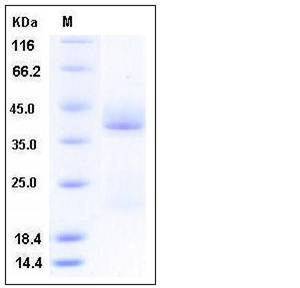Human CD69 Protein (His Tag)
AIM,BL-AC/P26,CLEC2C,EA1,GP32/28,MLR-3
- 100ug (NPP3712) Please inquiry
| Catalog Number | P11150-H08H |
|---|---|
| Organism Species | Human |
| Host | Human Cells |
| Synonyms | AIM,BL-AC/P26,CLEC2C,EA1,GP32/28,MLR-3 |
| Molecular Weight | The secreted recombinant human CD69 comprises 149 amino acids with a predicted molecular mass of 17.4 kDa. CD69 exists as a disulfide-linked homodimeric protein and migrates as an approximately 40 kDa band in SDS-PAGE under non-reduced conditions due to glycosylation. |
| predicted N | Ser 62 |
| SDS-PAGE |  |
| Purity | > 90 % as determined by SDS-PAGE |
| Protein Construction | A DNA sequence encoding the human CD69 (NP_001772.1) extracellular domain (Ser 62-Lys 199) was fused with a signal peptide at the N-terminus and a polyhistidine tag at the C-terminus. |
| Bio-activity | |
| Research Area | Immunology |Cluster of Differentiation (CD) |T Cell CD Antigen |
| Formulation | Lyophilized from sterile PBS, pH 7.4 1. Normally 5 % - 8 % trehalose, mannitol and 0.01% Tween80 are added as protectants before lyophilization. Specific concentrations are included in the hardcopy of COA. |
| Background | Early activation antigen CD69, also known as activation inducer molecule (AIM), is a single-pass type II membrane protein. Recently, cDNA clones encoding human and mouse CD69 were isolated and showed CD69 to be a member of the C-type lectin superfamily. It is one of the earliest cell surface antigens expressed by T cells following activation. Once expressed, CD69 acts as a costimulatory molecule for T cell activation and proliferation. In addition to mature T cells, CD69 is inducibly expressed by immature thymocytes, B cells, natural killer (NK) cells, monocytes, neutrophils and eosinophils, and is constitutively expressed by mature thymocytes and platelets. CD69 is involved in lymphocyte proliferation and functions as a signal transmitting receptor in lymphocytes, natural killer (NK) cells, and platelets. The structure, chromosomal localization, expression and function of CD69 suggest that it is likely a pleiotropic immune regulator , potentially important in the activation and differentiation of a wide variety of hematopoietic cells. This membrane molecule transiently expresses on activated lymphocytes, and its selective expression in inflammatory infiltrates suggests that it plays a role in the pathogenesis of inflammatory diseases. CD69 plays a crucial role in the pathogenesis of allergen-induced eosinophilic airway inflammation and hyperresponsiveness and that CD69 could be a possible therapeutic target for asthmatic patients. |
| Reference |
